Max Allan Collins's Blog, page 19
July 12, 2022
Mike Hammer, John Shaft & James M. Cain
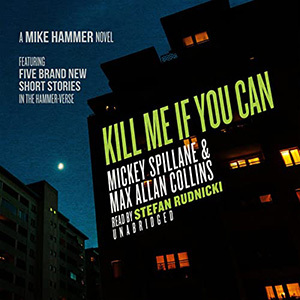
Hardcover:





E-Book:





Audiobook:



Coming in August, by Mickey Spillane and Max Allan Collins, is Kill Me If You Can, the 75th anniversary Mike Hammer novel (Hammer debuted in I, the Jury in 1947). It includes five Spillane/Collins short stories, two of which are Mike Hammer, both significant additions to the canon.
Kill Me If You Can will also appear on audio, read by the great Stefan Rudnicki, who for the past several Hammer novels has performed the impossible task of stepping in after Stacy Keach. The five short stories are included.
I have now done the commentary for the ClassicFlix Blu-ray 4K/3-D release of the 1953 I, the Jury. I think it went well, although I can’t compete with the likes of Tim Lucas and Tom Weaver (much less Eddie Muller) in their Blu-ray commentaries. Lucas and Weaver and Muller are always extremely well-prepared and organized, while I just watch what’s on the screen and blather on about all the useless information I’ve gathered and opinions I’ve formed over the years. I worked with my pal and partner Phil Dingeldein on this one – he shares credit but no blame. The Blu-ray comes out in early December.
Phil and I are preparing to shoot new material for an expanded Mike Hammer’s Mickey Spillane (1999) documentary as well as introductory material for the Brian Keith/Blake Edwards written-directed 1954 Mike Hammer pilot, which will be a bonus feature on the I, the Jury disc.
We are in the early stages of mounting an amateur stage production of Encore for Murder and are hoping to entice Gary Sandy to come to Muscatine, Iowa, to again play Mike Hammer. A few years ago, Gary starred as Mike in pro productions of Encore in Owensboro, Kentucky, and Clearwater, Florida. The play is performed in the style of a ‘40s radio show. Much more to follow, but the date to save is September 17.
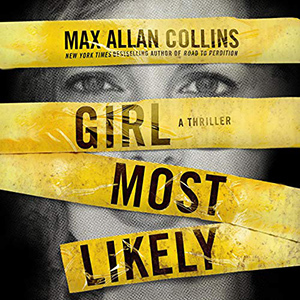
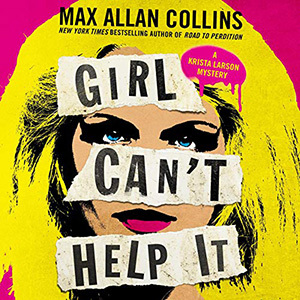
A reminder – the Kindle editions of the two books in my Krista and Keith Larson series, Girl Most Likely and Girl Can’t Help It, are on sale this month – right now through July 31. You can buy them as a pair for $1.98, or 99-cents each.
They are not on sale, but both Girl novels are also available on audio, read by my other favorite Collins narrator, Dan John Miller. [The Girl audiobooks are only $1.99 each if you own the eBooks. –Nate]
* * *If you swing by here now and then – or, God help you, on a regular basis – you will have noticed I seldom review books but frequently talk about movies and TV – of late, streaming mini-series more than anything. This week is no exception.
But first let me explain that I am indeed still reading books. Right now I am swimming in them, preparing to write Too Many Bullets, the RFK Heller novel that will cover both Jimmy Hoffa and Sirhan Sirhan. I am dizzy from it and driving Barb nuts with my ever-shifting notions about how I will approach this thing.
The degree of difficulty may make this the final Nate Heller novel, or at least one of such size and sweep. I can imagine doing shorter ones, more the length of a Quarry or Caleb York, which if Heller’s home remains Hard Case Crime makes sense. But the upcoming The Big Bundle was meant to be a “short” Heller and it ran over 400 pages in manuscript. As we say in the funnies, Sigh.
During intense research phases, little recreational reading happens. My brain wants something less proactive than reading, hence film and TV. I do read before bed and chip away at books. And my ambition is to read the entire Tarzan series by Burroughs and dig seriously into the complete Race Williams stories by Carroll John Daly and also the Zorro stories by Johnston McCulley. I read most of Burroughs’ Tarzan novels as a kid, but only recently have the complete Race Williams and Zorro stories been collected in book form.
Also on my reading list are books on Anthony Mann’s crime films, the handful of Willam March-penned novels I haven’t got to, a few remaining items by F. Hugh Herbert (creator of Corliss Archer), and autobiographies of Mel Brooks, Chuck Berry and Brian Cox. I’m also salivating to read Hell’s Half Acre about Kate Bender, one of my favorite true crimes of the Lizzie Borden era.
Am I alone in noticing that time is the enemy?
On the streaming front, Barb and I greatly enjoyed The Dropout, the jaw-dropping story of Elizabeth Holmes and her blood-exam scam. Stranger Things wrapped up in excruciatingly self-indulgent over-stuffed style – the Duffer brothers have got to stop writing teen romance! – but the horror aspects remained strong. And Star Trek: Stranger Worlds ended its season boldly going, and we continue to consider it the best post-Shatner/Nimoy/Kelley iteration.
Of course I am a hopeless addict of physical media, and snapped up two great Criterion 4K Blu-rays on their current Barnes & Noble 50% off sale – Shaft (1971) and Double Indemnity (1944).
Shaft is one of my favorite private eye films and it shows what might have been done with a Mike Hammer film had it been shot on gritty NYC locations (the 1982 I, the Jury remake comes close). Richard Roundtree is the most charismatic screen private eye since Bogart, and the Issac Hayes score ties with Mancini’s Peter Gunn for best P.I. theme. It’s really a pretty standard private eye yarn and very much on the Mike Hammer template – Shaft has a Homicide detective pal who scolds and yet uses him, and there’s a regular girl friend who the detective cheats on without a twinge, the violence is shocking and the P.I. is almost supernaturally tough, though he gets beat up before the end. Standard. But the Black twist on everything, those stark NYC locations, the pulsing soul score, the magnetic Roundtree…changes everything.
The movie looks great, sounds better, and the bonus features go on forever, though none of the experts mention Mike Hammer (the original hardcover novel had presented Shaft as the Black Mike Hammer) with no sense of the debt to Spillane on display here. There’s lots of feminist blather from a Black perspective, apologizing and rationalizing for what if this were a Hammer film would be labeled misogyny. But there’s a lot of good bonus material just the same, with Roundtree and Gordon Parks interviewed and much more. That includes the snappy quick sequel, Shaft’s Big Score (1972), on Blu-ray; it lacks the grit of the first film but has an incredible if absurd climax. Sadly M.I.A. is the underrated Shaft in Africa (1973). And if I’d have been in charge I’d have cherry-picked an example of the short-lived Shaft TV series, the episodes of which were movie length.
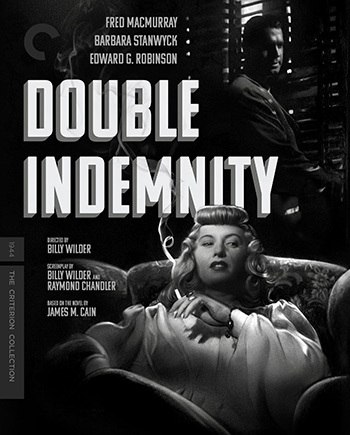
James M. Cain was one of the four writers who (sixty years ago) inspired me to go down the hardboiled path (the others being Hammett, Chandler and Spillane). Double Indemnity is generally considered the best of the screen versions, and was Cain’s own favorite. I could build a case for The Postman Always Rings Twice (1946) because it really does have a love story at its twisted heart. Double Indemnity, wonderful though it is, is cold at the center. Ironically (intentionally), the real love story is between Fred MacMurray’s Walter Neff and Edgar G. Robinson’s Barton Keyes, the insurance investigator who leads Neff and Barbara Stanwyck’s Phyllis Dietrich to their well-deserved fates.
It’s a great film, with Raymond Chandler’s crackling dialogue staying just to one side of self-parody; then there’s the prison-stripe window-blinds cinematography of John Sietz and march-to-doom direction of Billy Wilder. As Hammett’s The Maltese Falcon did with the private eye novel, Double Indemnity seems to invent, define and perfect the post-war film noir. Eddie Muller and Imogen Sara Smith do right by the film in their terrific bonus-feature discussion (accomplished by editing together craftily two sides of a chat shot in separate locations).
I disagree with them on only one thing: they describe both Neff and Phyllis as sociopaths. I think Double Indemnity is a dance between a guy who’s been getting away with things and a woman who’s been getting away with murder. There’s a throwaway line very early on where MacMurray mentions having sold vacuum cleaners door-to-door; this is code for the traveling salesman who is on the make for available housewives. He sizes Stanwyck up as one of those, with no idea how in over his head he is. He’s a regular guy with a sleazy streak who gets pulled into a murder plot because (a) he’s hot for the dame, and (b) he’s always dreamed of putting one over on the insurance company he works for. Stanwyck, on the other hand, has immediately sized him up as a horndog who is a perfect candidate for the inside-man accomplice she needs.
Muller and Smith discuss the difference between Cain’s novel dialogue and Chandler’s film dialogue, and are again on the money; but they don’t share the key anecdote in full.
Here’s what Cain himself said in that regard: “When they were making Double Indemnity in Hollywood, Billy Wilder complained that Raymond Chandler was throwing away my nice, terse dialogue; he got some student actors in from the Paramount school, coached them up, to let Chandler hear what it would be like if he would only put exactly what was in the book in his screenplay. To Wilder’s utter astonishment, it sounded like holy hell. Chandler explained to Wilder what the trouble was that Cain’s dialogue is written to the eye. That ragged right-hand margin that is so exciting and wonderful to look at can’t be recited by actors. Chandler said, ‘Now that we’ve got that out of the way, let’s dialogue it with the same spirit Cain has in the book but not the identical words.’ Wilder still didn’t believe him. They got me over there, purportedly to discuss something else, but the real reason was that Wilder hoped I would contradict Chandler, and somehow explain what had evaporated. But, of course, I bore Chandler out….”
* * *Lots of lists of the best Film Noirs have popped up lately, but this one is solid, and does a fine job discussing Kiss Me Deadly. And, of course, Double Indemnity is on it.
M.A.C.
July 5, 2022
Two Girls For Two Dollars!
The Kindle editions of the two books in my Krista and Keith Larson series, Girl Most Likely and Girl Can’t Help It, are on sale this month – right now through July 31. You can buy them as a pair for $1.98, or 99-cents each.
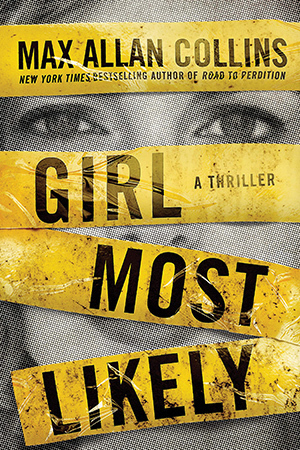
E-Book
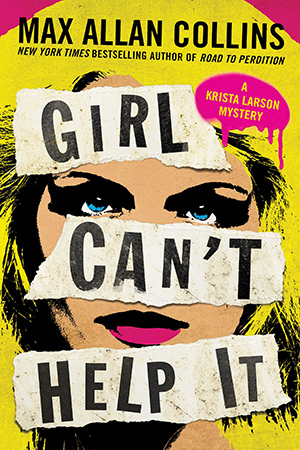
E-Book
While these two novels have done fairly well, their sales don’t compare to the bestseller status of the three previous books I did for Amazon’s Thomas & Mercer line, the Reeder and Rogers Trilogy (Supreme Justice, Fate of the Union and Executive Order), which sold in the hundreds of thousands.
I had hoped to do a third Krista and Keith novel, but so far the numbers haven’t justified that. Maybe this Kindle sale will change that. At any rate, if you like my work, I hope you’ll give them a try.
Full disclosure. Not all of my regular readers have loved them, including some mainstream critics who would have preferred new Nate Heller books; and of course my hitman Quarry has his own dark appeal. But one of the ways I’ve stayed fresh and enthusiastic over the years has been to try different things. That – in addition to creating income – was why I wrote so many tie-in novels in the ‘90s and early oughts: the chance to do different things.
In the two Girl books I was taking a conscious swing at writing an American take on Nordic noir. Matt Clemens and I (the Reeder and Rogers team) had already done What Doesn’t Kill Her for Thomas & Mercer (also a strong seller), which was intended as an American “answer” to The Girl With the Dragon Tattoo. With the Krista/Keith books I was working another shade of noir, again an American variation on the Wallander novels, and such Nordic TV mini-series as The Bridge, The Killing, and (again) Wallander.
As I prepared to write Girl Most Likely, I used my brilliant in-house sounding board, Barbara Collins, to try to come up with a setting that had some Nordic flavor while being resolutely American. We discussed Pella, Iowa, home of the Tulip Festival (and boyhood home of Wyatt Earp), in part because I liked the small town with tourist appeal aspect of the place. Meanwhile, Barb and I had taken to going to Galena, Illinois, for short post-project getaways, and it seemed an interesting, even ideal setting for what I had in mind.
Galena – as many in the Midwest know – is scenic little hamlet on a bluff with a downtown right out of Norman Rockwell, a tourist destination all year-round (winter sports a draw, though not for me). It’s a town of 3000 that is home to a million or more visitors a year, with sixty-some restaurants and various comfy hotels and bed-and-breakfasts and a quaint Americana vibe.
I got interested in how a police department in a city that size dealt with those million-a-year visitors. I’d been noodling with the idea of a very young female chief of police in a small town whose recently retired father was a former homicide detective. This concept slipped in perfectly with the Galena setting, and when I began my research I was pleased, even a little astounded, to learn that Galena’s police chief was in fact a young woman.
Chief Lori Huntington proved to be not only cooperative but generous with her time and information, and the books would have been lesser things without her.

I was pleased with the first novel, which dealt with a series of killings that accompanied a ten-year high school reunion (Krista’s class). Part of my self-mandate was to get away from the larger-than-life lead characters I usually write about in my mystery/suspense fiction – Quarry, Nolan, Nate Heller, Mike Hammer, even the CSI crew – and use more “regular” people for my protagonists. Folks next door who, in this case, happened to be a tourist-town police chief and her retired homicide cop father (from nearby Dubuque, just across the river), who had recently lost his wife to cancer and was flirting with suicide (a very Nordic notion).
As is the case with many thrillers, these regular people would be thrust into a situation ruled by larger-than-life crime and jeopardy. It’s a mix that has worked for everybody from Alfred Hitchcock to Mary Higgins Clark.
To me, my third-person, one point-of-view at a time approach – which included as much or more violence than I ever serve up – was business as usual. Only the subject matter, and the more normal protagonists, differed. But some self-professed “big fans” of my work – not many, but a few vocal ones – bitched about what they perceived as a radical change of pace.
A particular complaint of reviews (and, frankly, of my editor) was my somewhat detailed descriptions of clothing. I have always (and I’ve discussed this here) used clothing, grooming and the living quarters of my players to help characterize them. And anyone who’s attended a class reunion knows that how people dress at that event is very revealing of who they are (or who they’ve become, and who they want us to think they’ve become).
Did I overstep in this regard? Maybe. But my editor was so disturbed by this recurring criticism that she asked me to cut every clothing description in the second book – including that Chief Krista Larson wore a uniform. I resisted this request, as I don’t care to have my characters running naked through a book (in certain scenes, yes; but not an entire book).
Amazon is usually terrific at marketing, but I feel they slipped up with Girl Most Likely, which they debuted in the UK. That’s where the reviews got off to a bad start – the very American high school reunion theme was wrong for that audience, and some readers resented an old guy like me writing about a young female protagonist. And it may hurt the feelings of this Anglophile, but not everybody on the other side of the pond has a love for Americans.
The second novel, Girl Can’t Help It, represents only one of two times I’ve really addressed my rock ‘n’ roll years in a book (the other time was Scratch Fever, which is half of the current Hard Case Crime Nolan omnibus, Tough Tender). Again, while Krista and her father Keith are just folks, the killer is a dangerous, deadly force leaving a horrific trail behind her.
Yes, her. That’s another aspect of the novels that sometimes throws readers. In their point-of-view chapters, I don’t identify the killer (the first book’s homicidal point of view chapters are “he” and “him,” the second book’s are “she” and “her”), which limits the number of suspects. The mystery element is minor in both novels and it’s not terribly hard to figure out who is responsible in either one.
This seems to bother some readers, who brag about figuring out whodunit and then complain that they did.
If you have even casually followed my updates, you know that I from time to time offer book giveaways to prime the pump on Amazon (and other online) reviews of new titles. The review aspect of Amazon (primarily, but Barnes & Noble and various review blogs, too) is something relatively new. It used to be the newspaper and magazine reviewers were all an author had to worry about. The professional reviewers weren’t always nice, but they tended to be fair and accurate (they still do) (there are exceptions) (pretends to cough as he says “Kirkus”). I have mixed emotions about Amazon reviews. It’s an undeniably democratic method, but it also opens the door to readers with various agendas – everything from personal animosity to being the author’s mom.
But that’s the world fiction writers live in now. Girl Most Likely has a four-star ratings (averaged over 852 reviews) and Girl Can’t Help It a four-and-a-half star rating (averaged over 196 reviews). And yet here I am warning you (rather pathetically) that there are some Amazon reviewers who don’t like the books. It doesn’t help that the “top reviews” of both books begin with some of the worst ones. Why Amazon wants to discourage readers is beyond me.
Anyway, I like these novels, but I almost always like my own work, with reservations. When I listen to an audio book of my own stuff I am alternately smiling and wincing. I surprise myself when something strikes me as really good, and disappoint myself when something strikes me as not so good. I think that’s natural.
All I can tell you is these two novels came out exactly the way I wanted them to. And if you haven’t given them a try, I hope you’ll invest $1.98 (or at least 99-cents) and see what you think.
If enough of you do that, maybe I’ll get to do a third Krista-and-Keith. I promise not to over-describe the clothing.
* * *
On Saturday July 2, my band Crusin’ appeared in Muscatine at Proof Social on the patio in the late afternoon and early evening. It was a nice crowd, very responsive, applauding after each number.
Three-hour gigs wear me out. I admit freely to that, and the other two gigs this summer are two-hour ones, for which I’m grateful. I am very comfortable in front of an audience, generally, cases of nerves rare – the Iowa Rock ‘n’ Roll Hall of Fame induction concert in 2018 gave me a brief butterfly flurry, but frankly that’s the exception not the rule.
(Girl Can’t Help It opens with an induction concert at the Iowa Rock ‘n’ Roll Hall of Fame. Also a murder.)
But in the second of three sets Saturday evening, my amplifier started acting up – distorting badly. I am told nobody but me noticed it, but brother I did. And it threw me. Suddenly I wished I were anywhere else in the world doing just about anything else. That’s one of the oddities of performing – when it goes well, or even just okay, it’s a pleasure; when it goes wrong, it’s the worst.
On the following day, Sunday, I – as usual – felt like a bus had hit me. That’s not old age (entirely), as that’s always been the case the day after a gig. Nonetheless, I set up my keyboards and amp and tried to figure out what had gone wrong, second set. It appears to have been a problem with my volume pedal. I ordered a new one for about two-hundred bucks.
I made $100 for the gig.
Why do I do this?
Because I love it.
* * *Author Brandon Barrows (cool name) writes about his list of the best mob novels…and my prose novel Road to Perdition is one of them!
Some people think the Batman strip by Marshal Rogers should be reprinted. Gee, I wonder who wrote it?
This piece looks at Paul Newman’s last screen appearance…in Road to Perdition.
And, finally, yet another write-up about the gangster film you didn’t know came from a graphic novel (but you did, didn’t you?).
M.A.C.
June 28, 2022
Caleb York Nominated
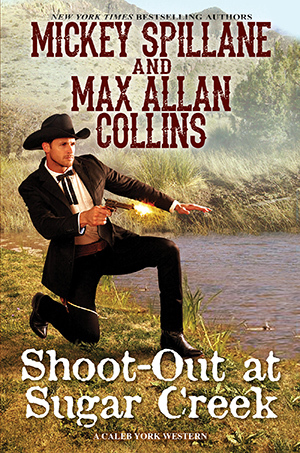
Hardcover:





Paperback:




E-Book:





Digital Audiobook





I’m pleased to say that my Caleb York novel – Shoot-out at Sugar Creek – has been nominated for a Scribe award.
Original Novel — General
Patient Zero, Amanda Bridgeman (Aconyte)
Shoot-out at Sugar Creek, Mickey Spillane & Max Allan Collins (Kensington)
Debonair in Death, Terrie Farley Moran (Berkley)
Winners will be announced at San Diego Comic-Con July 22, 2022. A full list of nominees in all categories is at the IAMTW.
This is a bittersweet but much appreciated honor. For whatever reason, neither the Spur nor Peacemaker Awards from the Western Writers of America and the Western Fictioneers respectively have ever honored the Caleb York novels. (I should say we did get a Best Novel nomination for The Legend of Caleb York from the Fictioneers, but nothing since.)
I would imagine I’m viewed as an interloper, a mystery/crime novelist moving in on their territory. It’s been a fun ride nonetheless. Kensington has not asked for more Caleb York novels, and I am making no approaches to other publishers, though the York sales have been strong enough to make that possible. It’s just that my goal for Caleb York was to fashion a novel from Mickey’s unproduced screenplay, The Saga of Cali York, written for John Wayne. I only did more novels because Kensington requested them, and, hey, who am I to turn down work?
But at this stage of the game, I’m starting to question that question. I am embarking on what may be the final Nate Heller novel, the potentially massive Too Many Bullets, and will likely be spending most of the rest of this year on it. My health is fine, considering the underlying factors, but I am particular about what projects I take on at this point.
It’s hard for me to walk away from a series. I really loved writing Caleb York, as I’ve been a fan of movie and TV westerns since early childhood – admittedly less so of western fiction. But those six novels satisfied a creative itch and I’m pleased to go out on a Scribe nomination. The paperback of it is coming in October.
The Scribes honor writers of movie novelizations and TV tie-ins, as well as authors continuing characters begun by famous writers like Robert B. Parker, Edgar Rice Burroughs and, yup, Mickey Spillane. This is the first time I’ve submitted a Caleb York novel to the Scribes, as members are limited to one submission in a category, and previously I submitted Mike Hammer novels to the General Fiction category (winning several times, I’m pleased to say).
Those keeping score may recall that Lee Goldberg and I founded the International Association of Media and Tie-in Writers (IAMTW) a decade and a half ago. Lee, having more class than me, never submitted his work to the awards given by an organization he co-founded. I, of course, having no shame, have been a frequent nominee and occasional winner.
The reason why I have no shame is that the real shame goes to the writing organizations (you know who you are) that have ignored tie-in writing throughout their existence, as if the talented writers creating novels and short stories in their respective fields (science fiction, mystery fiction, horror, western) didn’t exist at all.
I know from the mail I’ve received over the years (snail and e-) that most readers don’t make that distinction. The role that Star Trek and Star Wars novels played in keeping those franchises alive during periods when Hollywood’s versions lay fallow cannot be overestimated. My publishers frequently mention that I am the author of Saving Private Ryan and Air Force One (among others) without bothering to mention they are novelizations. Until the recent Reeder & Rogers political trilogy came along, my CSI novels (written, like that trilogy, with my gifted co-writer Matthew Clemens) were my bestselling mystery/crime novels…and introduced hundreds of thousands of readers to my work.
So I am proud to be co-founder of the IAMTW, and will bear up under the shame of participating in their awards.
* * *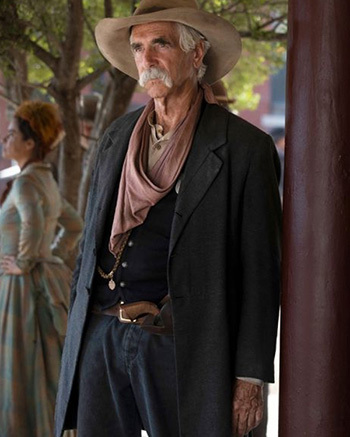
Speaking of westerns, among the streaming series Barb and I have been watching is 1883, which is supposedly a prequel to the very popular Yellowstone. We tried the latter and somewhere in the second season got irritated with it, so we avoided the prequel for a while. We shouldn’t have.
My love for Sam Elliot as perhaps our last great western icon in the Hollywood sense finally prompted us to watch, and it’s a fine show – tough, heart-felt, and more historically accurate than most. (Really it should be set at least ten years earlier, but apparently that would screw up its prequel-to-Yellowstone timeline.) Everyone on this series is good, but Elliot seems to sense this is a career-capper and his rock-hard surface hiding tender humanity – he is sort of the ultimate “tough love” advocate – sums up everything we admire about his work.
1883 is on Paramount-Plus, and I’m finding it the best of the handful of streaming services of which I partake. Star Trek: Strange New Worlds continues to honor the memory and approach of Roddenberry while updating it. Barb and I glance at each other every episode and at some point one of us says, “Can you believe it’s 2022 and we’re watching new Star Trek?”
And real Star Trek at that.
The Offer wrapped up very well. Having read a bit about the actual filming of The Godfather, I am aware a certain amount of sugarcoating, not to mention artistic license, is afoot here. But I was shocked by the swells of emotion I felt in the knowledge that the characters have achieved their goals and were about to go on with their lives without me. For me, Miles Teller is the standout in a cast that I would have to say is flawless (well, the Sinatra guy could have been better).
Also viewed streaming (it’s available a couple of places) is a three-and-a-half-hour Bollywood movie my son badgered me to watch – RRR. It is an absolutely bonkers action spectacle that makes Raiders of the Lost Arc look like a documentary about archeology. They fight, they sing, they dance, they romance, they make sure we know the Brits were stinkers. It’s absurd and childish and sophisticated and three hours and a half just blow by. I cannot do RRR justice, other than to say – don’t leave the planet before you’ve experienced it. (My favorite scene had to do with the massive cages of wild beasts being unleashed on a British nighttime garden party.)
You’re welcome.
* * *One of the things about writing a weekly blog, with a specific deadline, is that everything else can get in the way.
Today I have to prep for the commentary I’m doing tomorrow morning (at Phil Dingeldein’s studio in Rock Island) for the ClassicFlix 4K Blu-ray (and 3-D) release of the 1953 I, the Jury, something I had only dreamed might one day happen. But the prep will not be easy, as there is much to discuss.
Last week I was in a foul mood and did not feel well, and dragged myself through this bloggy process. And if it showed, well, you’re not paying anything for this. Don’t bitch.
However. I performed the kind of screw-up I am well-known among my friends and associates (not mutually exclusive groups) for performing: I posted the four gigs of my band Crusin’ this summer and managed to leave out one of those dates, while thoughtfully including the times and places. You can’t have everything.

Before I present the revised schedule, I’ll mention that Crusin’ appeared last Friday night (June 24) at Ardon Creek Winery. It’s a lovely outdoor venue, and we were pretty good. The crowd was even better, numbering in the hundreds. A taco truck fed their tummies, and we fed their souls. It was fun, and I felt good throughout, relieved that my age had not dulled my rock ‘n’ roll skills appreciably since last year.
We had not appeared at Ardon Creek, one of our favorite venues, since pre-Covid, so it felt like a reunion. Barb was there – she helps me set up and tear down – and my son Nate, his wife Abby and their two kids Sam and Lucy came and capered on the surrounding green landscape that makes this particular venue so special.

I know these updates go out to readers, fans and friends all over the country, all over the world really, and what follows is strictly for Eastern Iowa and thereabouts. But here’s the rest of Crusin’s season:
Saturday July 2 we’re at Proof Social in Muscatine, from 5 to 8 p.m. On the patio, inside in case of rain.
Sunday August 14 it’s the Second Sunday Concert Series at Musser Public Library, 408 E. 2nd Street in Muscatine, IA. Sometimes it’s indoors, weather allowing outside in the parking lot. 6 to 8 p.m.
Sunday Aug 21 2022 – the Muscatine Art Center’s yearly Ice Cream Social, 1 till 4 p.m. 1314 Mulberry Ave, Muscatine.
* * *Here’s a nice John Sand review.
This piece looks at Road to Perdition on Netflix.
You have to scroll down a ways, but this is an in depth look at several of the Nolan novels, including the recent Skim Deep. [Note: the link is a PDF-format Internet magazine. The homepage is here.—Nate] The writer is very self-confident, smart and talky, but careless (my middle name is “Allen” in the first piece, and Richard Stark, it seems, writes about “Porter”). But it’s a deeper dive (a current term I despise) than Nolan is usually given.
Here’s a Spillane WW 2-era comic book story I didn’t know about!
M.A.C.
June 21, 2022
Sand Sale, Perdition, Hammer Theme, Spillane, Crusin’
There is another John Sand bargain this week – I believe it goes to the 15th of next month (July) – for the audio of To Live and Spy in Berlin. For only 99 cents! Brian J. Gill reads this (and the other two Sand novels) in a nice English accent that suits the material; really a great job.
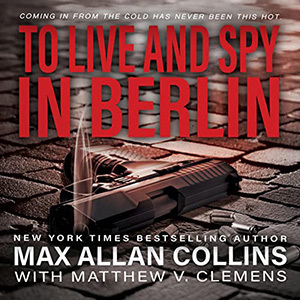 * * *
* * *Several friends and fans wrote me about a Daily Atlantic newsletter essay that selected Road to Perdition as an ideal Father’s Day movie. I liked the piece, even though it neglected to mention me, and was touched that the photo running with the article was from the sequence directly based on my first driving lesson with my late father. No bank robberies were involved in real life, however. I also like John Rooney being based on John Looney got a mention.
Here it is:
‘He Was My Father’Sometimes at the Daily we step back at the end of the week’s blizzard of news and current events and suggest something for your leisure time. It’s Father’s Day weekend, and so I want to recommend to you one of my favorite movies, a meditation on generations and fatherhood and loyalty and duty, a warm, nostalgic look at families during a simpler time, starring two of America’s most beloved actors.
I am talking, of course, about Road to Perdition.
If you have not seen it, Road to Perdition (based on the graphic novel of the same name, and widely available to stream) is a 2002 film about Irish gangsters in the 1930s. But it’s really about fathers and sons. A mob leg-breaker named Mike Sullivan, played by a bulked-up Tom Hanks, is fiercely loyal to his boss, John Rooney (played, in his last role, against type and with regal Hibernian menace by Paul Newman); indeed, Sullivan and Rooney have a father-son relationship.
But Rooney already has a son, played by Daniel Craig, and that son is a murderous psychopath. (People wonder why I had a hard time accepting Craig as James Bond. It’s because I saw Road to Perdition first.) Without giving away too much, Sullivan and his own young son, Michael, have to go on the lam. It’s a father-son road-trip movie, except with tommy guns and stone killers.
You may find this an unusual recommendation. Bear with me.
When Father’s Day rolls around, I naturally think of my own father. I have never been able to relate to all those Hallmark-card, Ward Cleaver images. My dad was a complicated man, which is what sons say when we mean “He was terribly flawed in a lot of ways, but he loved me.” He bore a lot of sins and had a lot of shortcomings, but he had a consistent code of ethics in dealing with others and he was known for it. He kept his word, paid his debts, and treated others with respect. He was the kind of man who would walk into a local bar and his peers would call him Nick but younger men would unfailingly refer to him as “Mr. Nichols.” Even our younger neighbors called him “Mr. Nichols,” with great affection. (When he died, I sold his house to one of the children who’d grown up next door to him.)
I think most of us had fathers who weren’t perfect. Mine wasn’t, and yet he taught me important things: Do an honest day’s work. Love your country. Do things you have to do even if they’re unpleasant. Never back down if you know you’re right. Be courteous in public.
He also taught me how to gamble and showed me how to spot someone dealing off the bottom of a deck of cards.
He wasn’t the blueprint for a good husband or father, and he knew it. When I was in my 30s, he admitted to my mother that he thought I’d grown up to be a better man than he was. This is a hard thing to learn about your father, a source of both pride and sadness. (I will have more to say about fathers, and the men I knew growing up, over on my Peacefield newsletter this weekend.)
Which brings me back to Road to Perdition. When Sullivan has to go on the run with Michael (played by a young Tyler Hoechlin), the son finally learns what the father he idolizes actually does for a living. He also learns that Rooney—based on the real-life Irish godfather John Patrick Looney—is not a kindly grandfather but a cold-blooded killer. These men (and this is very much a man’s movie) are scoundrels, but they have a code, and their obedience to that code leads them to tragic choices.
The last line of the movie (again, without spoiling anything) is what ties it all to my memories of my own boyhood. Young Michael reminisces, and says: “When people ask me if Michael Sullivan was a good man, or if there was just no good in him at all, I always give the same answer. I just tell them: He was my father.”
That is the most honest thing most of us can say about our fathers. We love them, and they love us, and that’s enough.
* * *My Brit pal Andrew Sumner, who edits my Mike Hammer novels at Titan (including the upcoming Kill Me If You Can), sent this great video.
He explains: “Due to my regular attendance at London’s finest jazz clubs, I’ve become friendly with a well-known UK swing/jazz R&B performer called Ray Gelato. Ray leads a band called Ray Gelato and the Giants and they essentially channel the energy of Louis Prima & Louis Jordan – they played Paul McCartney’s wedding, they’ve supported Queen, etc. They’re in a similar wheelhouse to Brian Setzer and Big Bad Voodoo Daddy.”
Andrew was nice enough to request that they play “Harlem Nocturne,” Mike Hammer’s theme in the Keach era, and dedicate it to me. Have a listen and look (or is that a butcher’s hook?).
* * *If you’re a huge Spillane fan or huge Collins fan or just huge masochist, you may wish to watch this entire ninety-minute interview of me (on the subject of Mickey) by Dan Scheider (he’s very’s good) featuring the great Kevin Burton Smith of Thrilling Detective fame and accomplishment.
* * *On another musical note (or two or three or four), my band Crusin’, 2018 inductees in the Iowa Rock ‘n’ Roll Hall of Fame, will be playing four dates in Eastern Iowa this summer and early fall.
First up, on Friday June 24 from 6 to 9 p.m., is the Ardon Creek Vineyard in the gently rolling farmland of “76 Township” in Eastern Iowa, approximately 30 minutes southeast of Iowa City, Iowa, 15 minutes southwest of Muscatine, Iowa and 5 miles north of Letts. Here’s the address: 2391 Independence Avenue, Letts, IA 52754. Their phone is (563) 272-0028 and more info’s available here, including a map.
On Saturday July 2 we’ll be at Proof Social in Muscatine, from 5 to 8 pm. We’ll be on the patio unless there’s rain, in which case we’ll be inside. This is a lovely venue, and the patio overlooks the Mississippi.
On Sunday August 14 we’ll again be appearing as part of the Second Sunday Concert Series at Musser Public Library, 408 E. 2nd Street in Muscatine, IA. Sometimes it’s held indoors and other times, weather allowing, with an outdoor stage in the parking lot. Hours are 6 to 8 p.m.
Finally, we’ll be appearing at the Muscatine Art Center’s yearly Ice Cream Social, which runs from 1 till 4 p.m. (Our times are 1:15 to 2:10 and 3 to 3:45.) 1314 Mulberry Ave, Muscatine.
Yes, our “season” is short, which is on purpose. Again I wonder if this will be the last year for Crusin’ appearances. And my memory fills with my departed bandmates, including the most recent and cutting loss, bass player Brian Van Winkle. I hope he’s somewhere arguing with Paul Thomas, Chuck Bunn, Bruce Peters, and Terry Beckey who among them gets to play bass if that Rock ‘n’ Roll Heaven gig comes through. But knowing Brian, he’d just smile and wait his turn.

Crusin’ at the Moose in January 2022* * *
Check out this wonderful Quarry’s Blood review at the web’s definitive genre book review site, Bookgasm.
Here’s a nice Goodreads review of the graphic novel, Road to Perdition.
And finally here is The Big Bundle at the Hard Case Crime web site.
M.A.C.
June 14, 2022
An Essential Noir Blu-Ray, A Spillane Update and Final Episodes
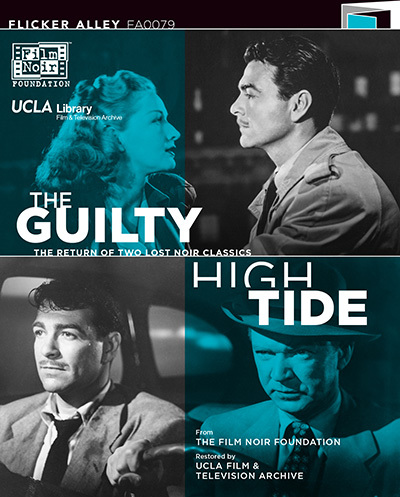
My pal Eddie Muller, the guru of all things noir, has outdone himself with the latest Flicker Alley home video release from the Film Noir Foundation. Beautifully restored as usual by the UCLA Film & Television Archive, Eddie’s first double feature on Blu-ray/DVD is The Guilty/High Tide, both 1947 releases from (of all people) producer Jack Wrather of early TV’s Lone Ranger and Lassie (!) fame.
What makes the disc a noir fan’s feast are the special features, many of which are the work of film expert Alan K. Rode, including documentaries on Wrather (and his actress wife Bonita Granville, star of The Guilty), Cornell Woolrich, and director John Reinhardt. The standout special feature for me, however, is Lee Tracy: The Fastest Mouth in the West from charming, articulate noir historian Imogen Sara Smith.
Lee Tracy is a nearly forgotten movie (and stage) star of the 1930s who has long been a favorite of mine. He defined the Hildy Johnson character in The Front Page on Broadway. He didn’t play the role on screen (Pat O’Brien did) but he went on to be the prototypical fast-talking, rule-bending, hard-drinking, sleazy-but-winning media-man of pre-Code Hollywood. He is remembered, if at all, for his most enduring films, Doctor X, Dinner at Eight, and Bombshell. He made a late career comeback on Broadway and in the film version of Gore Vidal’s The Best Man (1964), playing a Truman-esque ex-president turned power broker – he got an Academy Award nomination for that. A terrific film, by the way.
His career downfall in the mid-‘30s came when he supposedly urinated from a balcony onto a passing parade of Mexican soldiers (he was making Viva Villa!). He was apparently as hard-living and hard-drinking as the characters he portrayed. For me, he’s a unique figure, fast-talking and oddly charismatic despite a face that looks like a sack of potatoes wearing a sly smile. He is pre-Code Hollywood wrapped up in one balcony-pissing package.
Eddie Muller, who participates in several of the documentaries and delivers his usual fine introduction to the films, is more impressed with The Guilty than with the Lee Tracy-dominant High Tide. The Guilty is definitely worthwhile, an Ulmer-esque exercise in making something out of nothing, budget-wise.
The Guilty is also one of the best translations of the mood of writer Cornell Woolrich to the screen. Rear Window is obviously – I’m no genius pointing this out – superior; but then so is The Window with Ed Gorman’s first cousin Bobby Driscoll and Phantom Lady and on and on. What The Guilty has, besides cannily used shabby sets, is its doomed lead actor, Don Castle – who is also in the Woolrich-based I Wouldn’t Be in Your Shoes (1948) and of course High Tide. Castle rivals Tom Neal for sad irony in his real life, ending a suicide.
I will state, at risk of losing whatever noir credentials I have, that I am not in particular a fan of Woolrich’s writing. He was justifiably famed for his ability to come up with one resonant noir premise after another; but as a writer he did not do much for me. I once was hired to write a screenplay from a novel of his (never made) and was not impressed with the craftsmanship. This is a matter of taste and I acknowledge his importance on a very short list that includes Hammett, Chandler, James M. Cain, Horace McCoy, Mickey Spillane, and Jim Thompson.
The sadness and threadbare nature of Woolrich’s life is well-served by The Guilty, but for this fan of actor Lee Tracy, High Tide (with which I was already familiar) is the gem of this rhinestone-glittering package. Like The Guilty (and I Wouldn’t Be in Your Shoes) it’s from Monogram. I once had Nate Heller say, “The night was as starless as a movie from Monogram.” But Lee Tracy must have slipped my mind. Typically, in both The Guilty and High Tide, Regis Toomey shows up as essentially the same plainclothes police inspector (he has that role in I Wouldn’t Be in Your Shoes, too, more centrally).
High Tide has a wraparound right out of Double Indemnity and a bigger budget than The Guilty (considering it’s Monogram, nothing to brag about) but it serves as a coda, or even valedictory, for Lee Tracy’s fast-talking, rule-breaking reporter, a figure recognizably American, at once admirable and shameful.
Tracy was no longer A-list in 1947 and hadn’t been for well over a decade; he was making the occasional B picture. He would soon gain a slight, tenuous hold on noir history by way of starring in the first really successful tough private eye series, Martin Kane. Surviving examples of this early ‘50s show are fascinating artifacts of live TV. But in High Tide the actor brings his trademark persona fully into the bleak world of film noir, where leads are played by the doomed likes of Castle and Neal. He fits in well but flies much higher on his way to High Tide’s splash landing.
Thank you, Eddie Muller, Alan Rode, Woolrich documentarian Steven Smith, and especially Imogan Sara Smith, for her wonderful career piece on Lee Tracy.
* * *In the meantime, I am preparing to do the commentary for ClassicFlix’s I, the Jury release this coming September. It’s going to be really something – a package including 4K, Blu-ray and 3-D. Preparing for my work, I have watched a 3-D advance disc of the 1953 film and was again blown away by John Alton’s cinematography.
I have always liked this film – it was my first introduction to Mike Hammer, seen on a very small black-and-white TV around 1955 – and I know that some people don’t accept Biff Elliot as Mike Hammer. Mickey didn’t, and he’s not alone. But I find Biff’s take on Hammer as a young, not terribly bright combat veteran, out to avenge the guy who lost an arm to a Japanese bayonet meant for him, both appropriate and effective – burly but not a bully. The flaws in the film mostly have to do with censorship issues – the truncated striptease at the conclusion particularly, but also the lengths the script has to go to, to avoid directly mentioning prostitution and dope dealing.
I will talk more about this later, but anyone interested in Mickey Spillane and Mike Hammer…really, any film noir fan…will find the Classicflix I, the Jury on a short list of best Blu-rays of the year, including no doubt The Guilty/High Tide.
* * *Elsewhere on the Spillane front, I am working on the galley proofs of Spillane – King of Pulp Fiction, and find myself very pleased. It was a big, hard job – Jim Traylor and I have been seriously working on this project since shortly after Mickey’s passing in 2006 – and I am relieved to find that I like the result. Jim is working on the index of the 350-page book right now.
I am thrilled that Mysterious Press is the publisher. It’s a classy imprimatur that I think this book deserves.
* * *Our first post-Covid lockdown walk-out on a movie: Jurassic World: Dominion. The dinosaurs were believable, but the people were not. Just a dreadful, dull script with brain-numbing dialogue. I had thought this would be a nice melding of characters from the previous entries in the saga, but (for the hour-plus we witnessed) they rarely interacted.
We saw it in 3D that was barely noticeable (but for the upcharge). I was tempted to stay and watch at least some of the actors get eaten, but Barb was fed up.
I will say I thought the overhead sound conveying the prehistoric creatures grazing and grunting was effective until I realized it was just the other moviegoers.
On a more positive note, several of the limited-run TV series we’ve been watching have wrapped up satisfyingly, particularly Gaslit and (an episode to go) the delightful The Offer (I recommend supplementing the series with the behind-the-scenes Godfather book, Leave the Gun, Take the Cannoli by Mark Seal). HBO’s The Staircase remained compelling viewing in its final episode, but as it’s credited with being based on the French documentary of the same name, one does wonder where material not seen in the doc came from. Some of it seems unfair to all concerned. Anyway, that owl did it.
* * *Finally, it’s another article about that Tom Hanks movie that you didn’t realize came from a graphic novel.
M.A.C.
June 7, 2022
54 Years and Counting! (Really 56.)
Barb and I took our first post-Covid lockdown overnight trip, celebrating our 54th wedding anniversary last week – specifically, on June 1st, the day of, and returning to Muscatine on June 2nd, the start of year 55.
It was a delightful trip, although two business situations back in the real world came up shortly after we arrived in Galena, Illinois (our favorite getaway spot) and reminded me how nice life was when you didn’t have a cell phone in your pocket.
Things settled down, though, and we shopped and lunched at Vinny Vanucci’s and had a lovely evening, dining at Fritz and Frites and then sharing a quiet, typically Collins evening in our suite at the Irish Cottage – see the photos as evidence.


You will note that I look almost giddy sharing a table with a beautiful blonde, undeterred by having spent 56 years of my life with her (we started going together in 1966). There are numerous reasons not to like me, even to hate me, but none better than my managing to hornswoggle (one of my late father’s favorite words) her into spending most of her life with me.
Obviously Barb is a beauty. But she is also funny and smart and ridiculously thoughtful. She loves the Three Stooges. She loves the Beatles. She loves the original Star Trek. She loves James Bond. She loves her grandchildren. And she even loves me.
The question we get most often is how we write together and remain married. I’ve seen other writing couples really struggle with that. My answer sounds flip but it’s true: our offices are on separate floors.
Another major factor is that we develop the idea for a story or novel together, often over lunch or on a car ride, and then she works alone on her draft, checking in with me only if she hits a rough patch and wants an opinion (rare). She does not love to write. I try to tell her that no writers really love to write, though many of us are compelled to do so, and all of us love to have written. But she entered the field basically to help me out, editing, and writing the “Mike Mist” feature for Ms. Tree after I burned out on minute mysteries.
So when she finishes a draft of a novel, she claims (believably) to be sick of it. She doesn’t care what I do with it. This is basically true, but if my draft wanders too far afield from what she had in mind, she’s very tough-minded about getting me back on track.
We just finished our short novel, Cutout, for Neo-Text. I say “finished,” but we haven’t heard back from the editor, so you never know when rewrites are requested. But it feels good and was very much an idea that came from Barb and a story that she generated. The Antiques novels are fairly loose and it’s not unusual for long stretches to be my work; but in Cutout, her writing was so tight that working on it, trying to improve on it, was like repairing an expensive watch.
So feel free to hate me for being so lucky in having this life partner. I don’t deserve her. But at least I know it.

We wrapped up our anniversary celebration with a concert – Frankie Valli and the Four Seasons. Really, it was Frankie Valli and four back-up singers/dancers, but I’m not complaining…it was a great show. Held at the cavernous and unfortunately named TaxSlayer Center in Moline, the concert featured an amazingly spry eighty-eight year-old Valli hitting all the high notes and giving a long, opening-act-free presentation of most of his many hits, without and without the Seasons. A multi-media affair, with a fantastic rocking band, it had a Vegas feel that made other oldies shows I’ve seen look and feel like the cobbled-together affairs they often are.
The event had been postponed twice, and we almost skipped it, having already had a fun but exhausting Galena trip. But we were very, very glad we saw this pop music legend in performance.
* * *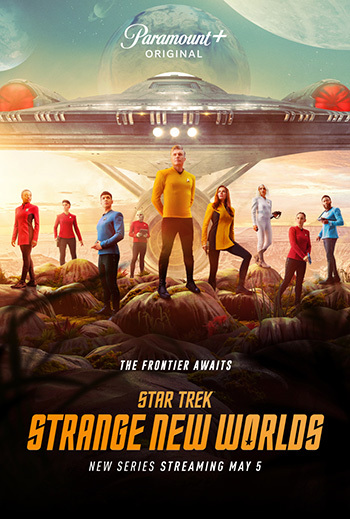
Among the list of things Barb loves I listed Star Trek. We loved all the movies, including the one Shatner directed, and the recent J.J. Abrams reboot features, which not everyone does. We are okay with Next Generation, but every other ST series has left us cold – we haven’t ever boarded those vessels, not long-term.
I was once approached to do a Star Trek novel and was thrilled. It was to be about the newest, about-to-debut series, Enterprise, which I was told was a throwback to the original series. I watched the premiere, all revved up – it starred Scott Bakula, from Quantum Leap! But then it turned out to, well, uh…suck. At least in my opinion. And Barb’s.
I tried to get the book gig anyway, but both my tries were rejected because they resembled this episode of that Trek spin-off or that episode of this one.
Now comes Star Trek – Strange New Worlds, and we are both fans. It’s basically the series that Gene Roddenberry first intended to do, as indicated by the pilot (“The Menagerie”) with Jeffrey Hunter as Captain Christopher Pike, Majel Barrett as Number One, and Leonard Nimoy as Spock.
Strange New Worlds (streaming on Paramount Plus) is a smart, respectful prequel with a great cast. Anson Mount as Pike seems to combine the best of Kirk and Picard, Rebecca Romijn as Number One is a particularly strong presence, and Ethan Peck as Spock channels Nimoy to an eerie degree, particularly the sound and cadence of the original Spock’s voice.
The art design and special effects are stellar (sue me) and the stories so far mostly take place on the stunning Enterprise itself. The major difference is that none of the episodes to date are anything William Shatner would have put up with. Look, I love Shatner. (So does Barb.) He’s a force of nature and his Kirk is definitive. But he would never, never have allowed his episodes to focus so much on its ensemble cast. To Anson Mount’s credit, he holds the show together without flexing his ego.
This is the best Star Trek since…Star Trek.
* * *Thanks to all of you who took advantage of the week-long 99-cent sale for the Kindle edition of No Time To Spy, which collects the three John Sand novels by Matt Clemens and me.
We did not hit number one on any of the Amazon bestseller lists (The Shrinking Island recently did) but we got into the upper reaches.
For those of you who (like me) prefer physical media, the “real” book of No Time to Spy is a fat thing of beauty.
You can get it here for $15.99.
* * *Finally, here’s another of those “movies you didn’t know were based on comics” pieces, but not a bad one (on Road to Perdition of course).
M.A.C.
May 31, 2022
No Time to Spy 99, OSS 117, and Stranger Things 4
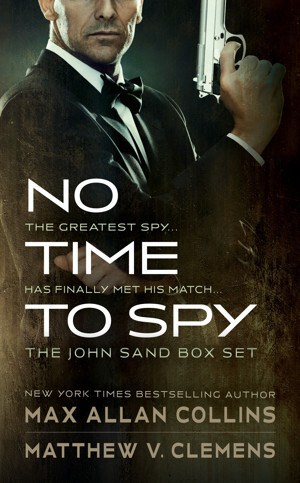
E-Book:

Paperback:

No Time to Spy – the collection of the three John Sand novels by Matt Clemens and me – is going on sale for an astonishing 99-cents (for the e-book) at Amazon starting today (May 31 at 12 a.m.) and ending June 6 (at 11 p.m.). Those are Pacific times.
For those of you who haven’t tried these books, this is an excellent low-cost opportunity. The response has generally been very good to the Sand novels, but a couple of supposed “big fans” of mine have attacked them for various reasons that seem specious to me. For one thing, they apparently don’t understand that the John Le Carre school of spy fiction (which I admire) is different from the Ian Fleming school (which I adore).
The premise of the trilogy, as you may know from previous updates here, is that John Sand is the real-life spy that James Bond was based on, and that Ian Fleming was a colleague who used Sand’s experiences as a basis for his fiction. The publicity that Sand receives as the basis of Bond forces him out of the spy game; also, he marries a very wealthy young woman – a Texas oil heiress – in an echo of what occurs in both the book and film of On Her Majesty’s Secret Service, minus the tragedy.
Matt and I never mention Bond and Fleming by name, but it’s obviously an open secret. The books are larger than life, in the fashion of the Bond novels and films, but are at the same time quite tough and the frequent action can be violent, even shocking. The sexual content is largely limited to the married couple’s couplings.
The novels are, in order: Come Spy With Me; Live Fast, Spy Hard; and To Live and Spy in Berlin.
Matt and I had hoped to do at least one more Sand novel, but despite general positive reader response, sales have not encouraged us to do so. If this 99-cent sale pushes us onto Amazon bestseller lists, even briefly, that could change.
The ignorance of the handful of readers who have denigrated the books for being spoofs are the kind who can’t see the difference between Harry Palmer and Austin Powers.
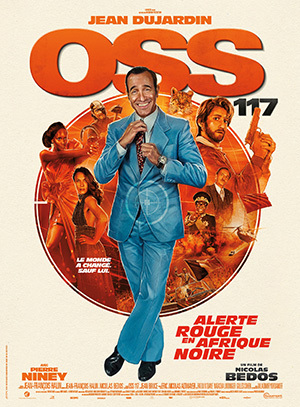
This is not to say I don’t like a good Bond spoof, and a third in the film series of what is (in my opinion) the greatest satiric response to Bond is now available – OSS 117:
From Africa With Love, again starring Jean Dujardin (of The Artist fame) as secret agent Hubert Bonisseur de La Bath. The third film does not seem to be on any of the streaming services, but can be purchased on Blu-ray and DVD at Amazon.
The first two films, OSS 117: Cairo, Nest of Spies (2006) and OSS 117: Lost in Rio (2009), are also available from Amazon in French with English subtitles on both Blu-ray and DVD. E-bay has both of these from various sources. E-bay also has From Africa With Love, but I ordered editions listed as having English subtitles and it wasn’t till my third try that I landed on a version that had that essential option. I would stick with ordering from Amazon.
What’s great about these films – they are strictly parodies of the Connery era, the star physically resembling the “real” James Bond – is that they work as Fleming-style spy stories with the hilarious inclusion of a Bond clone who is bone-headedly politically incorrect and in some ways a dope…and yet he’s a credible action hero. None of the other parodies of Bond accomplish that.
This new film finds OSS 117 actually growing and changing by the final scene…perhaps not dramatically, as it would appear his growth is largely limited to not patting the asses of the pretty females at the spy office as a greeting.
And you will adore the opening credits with the fake Bond theme song and faux Maurice Binder visuals.
I love these movies and wish they were more readily available. But if you’re a Bond fan, you need to see them. Also worthwhile is the boxed set of the original French OSS 117 films, which are among the better Bond imitations of the ‘60s.
* * *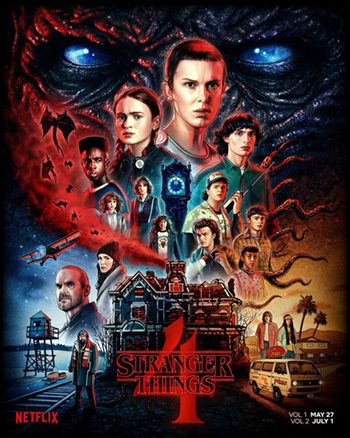
I wrote at some length last week about the assorted streaming mini-series we have been watching. We picked up on season four of Stranger Things, which Netflix has just “dropped” as they say (an expression I could do without). I will tell you right now that Barb bailed before the end of the first episode, and I don’t blame her.
Having really liked the preceding seasons, I hung in there and watched the first two episodes – which were long, around an hour and twenty minutes each, far too long for a premise as wispy as that of Stranger Things. I have continued on and will stick it out to the end.
But the opening two episodes are a tough go. They present a version of high school that is simplistic and ridiculous – for example, El (who has lost her powers and apparently also her spine) is picked on by…everybody, at a school filled only with bullies. Several new annoying characters are introduced right when we’re trying to remember who the recurring characters are, some of whom are hard to recognize at first. After all, it’s been three years, real time, since the previous season. The kid actors all look much too old for the six months, story time, that have elapsed. Those annoying new characters include a rebel who looks to be about 35 and a pizza delivery hippie whose sub-Cheech-and-Chong comedy relief is painful to endure.
When the high school stuff fades and the sci-fi/horror stuff kicks in, Stranger Things gets back on recognizable track, uneven but rewarding. The biggest problem is the shifting tone, with the Winona Ryder storyline comic (despite tragic circumstances) and her sidekick conspiracy theorist, bearded Brett Gelman, often uncomfortably hammy.
The first two very long episodes are written and directed by the creators, the Duffer Brothers. Surprisingly, it’s the subsequent episodes by other hands that are what bring the season around. The creators seem to let their actors go over the top, unbridled, with Gelman (much better in non-Duffer-directed episodes) and newcomer Joseph Munson (the rebel Eddie Munson…get it, Munster?) their chief victims. These first two episodes are weak on Direction 101 items like matching action and, well, pacing.
The pop culture references get laid on a little thick, too. We have Robert Englund repeatedly scratching his insane asylum-cell table with his fingernails (Freddie Krueger, get it?) and the kids entering a haunted house right out of (the much better) It. Krueger is playing Victor Kreel (Victor Crawley horror franchise, check) as he subs for Hannibal Lecter offering convicted-serial-killer advice from his cell.
Why watch?
Well, once you get past the first two ill-judged episodes, the Eleven story kicks in, in a satisfying way. Most of the young actors are terrific, especially Sadie Sink (and her character is into Kate Bush, which reveals good taste on somebody’s part, probably the Duffers, giving credit where it’s due). Really, all of the recurring characters are fine, with Millie Bobby Brown a standout, once she ditches the suddenly-El-is-a-five-year-old bit. Of the original group Gaten Matarazzo remains winning – the heart of the ensemble.
It’s not the Duffer Brothers’ fault that Covid happened and three years passed, damaging the believability of cast members as kids younger than they’re playing. That a number of new actors were cast as teenagers and look at least thirty is the creators’ fault.
What I think happened is this: the brothers were in the right place with the right idea at the right time to be one of the first binge-worthy shows, really jump-starting Netflix. But in the meantime some other gifted creators have taken advantage of the limited-season, limited-series approach, and upped the ante. This season of Stranger Things does not compare to Gaslit, The Offer, The Staircase, or Better Call Saul.
Not even close.
* * *Road to Perdition is on this list of the best noirs to date of the 21st Century.
M.A.C.
May 24, 2022
A New Novella, TV Mini-Series Reviews and Legacy Books
This week I am working on my draft of the last five chapters of Cutout, the novella Barb and I are doing for Neo-Text. It will appear as a trade paperback, available through Amazon, and of course an e-book. No pub date yet, but Neo-Text moves fast.
Cutout marks Barb’s return to her tight, third-person style that she honed in her years writing short stories, which culminated in the novels Regeneration and Bombshell, co-written by me (now available from Wolfpack – the trade paperbacks are lovely).
We have, of course, been writing the Antiques series since then, and it’s been a long-running success, although we were not offered a new contract by Kensington and moved to Severn, where Antiques Liquidation (our second Trash ‘n’ Treasures mystery for the UK house, after Antiques Carry On) will be published on October 4.
Barb had begun to get an itch to do something else, as evidenced by a short story we co-wrote that appeared not long ago in Ellery Queen Mystery Magazine (July/August 2021) under our “Barbara Allan” joint pseudonym. For over a year she’s been mulling (her maiden name is Mull) doing an espionage-tinged novel called Cutout, and we discussed it often, plotting it over a restaurant lunch (as is our habit). I came to feel it was either a novella or a young adult novel, in part because its protagonist is a young woman in her freshman year of college, but also because it needed to be probably no longer than 40,000 or at most 50,000 words – at least as initially conceived. Barb had in a mind a very spare, almost minimalist style for this one.
With Neo-Text a market for my novellas – witness Fancy Anders Goes to War – we decided to go with that length, which will be in the neighborhood of 30,000 words.
We were able to sell it to Neo-Text on a basis of the first third or so of the manuscript plus a fairly detailed synopsis. I’ve been doing my drafts of chapters with Barb out ahead of me, and now she’s completed her draft and I have five chapters (of sixteen) to go.
All I can tell you is it seems very, very good to me.
I will keep you posted.
* * *We seem to be in a sort of Golden Age of TV mini-series, thanks to the hungry eye of streaming services. I would like to point out a few that might be worthy of your time.
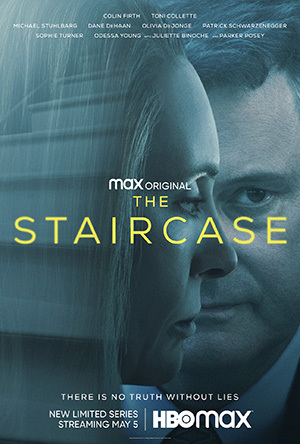
The Staircase (HBO, streaming on HBO Max) charts the notorious Michael Peterson case, in which the author of Vietnam thrillers is accused of the murder of his wife. This true-crime-based drama was already the subject of a well-known documentary, streaming on Netflix, also called The Staircase. The documentary is fascinating and, while somewhat flawed in stacking the deck at least slightly in Peterson’s favor, a worthwhile watch, despite its thirteen-episode length. But the dramatic mini-series is its own animal and quite good, dealing with material not covered in the documentary, including much more about Peterson’s wife and family, his experiences in prison, and the seemingly ridiculous but actually compelling theory that the wife was killed by an owl (!). Peterson in real life is a complex character, at first an apparent sociopath but then seemingly human and even a victim. It’s a whipsaw experience, watching both the documentary and the dramatic version. The centerpiece of the latter – a meta experience that includes the making of the documentary within its own narrative – is the remarkable Colin Firth as Michael Peterson.
Two more true-crime based mini-series may be of interest to you – they were to me. But both take a less serious approach to the material, casting real-life melodrama in a manner reminiscent of a John Waters movie.
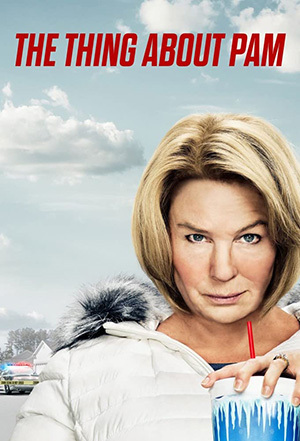
Candy recounts the at-one-time household name murder case from 1980 in which one church-going housewife killed another church-going housewife with an axe, wielding enough blows to make Lizzie Borden look like an under-achiever. Candy Montgomery – the case is the subject of a famous true crime book co-written by John Bloom (Billy Bob Briggs!) – plotted her affair with Betty Gore’s husband as if it were a Brinks truck robbery. But she somehow killed Betty with that axe (the jury agreed) in out-of-control self-defense. The dark absurdity of the case lends itself to creator Nick Antosca staging everything Waters-style, with kitschy late ‘70s/’80s sets and Sears catalogue costuming and blatantly fake wigs and a musical soundtrack more appropriate for a sitcom than a tragic docudrama. Jessica Biel plays Candy peanut-brittle brittle, aggressively upbeat. The subtext here is that Candy was guilty.
But if you watch the 1990 TV movie with Barbara Hershey (it’s on You Tube and out-of-print DVD) – A Killing in a Small Town – you’ll find a strikingly similar film as to content, with the tone and approach wildly different. For one thing, Barbara Hershey is a world-class actress who actually sells Candy’s unlikely innocence. For another, the tragedy is treated not as a dark joke but…a tragedy. The 1990 film (only ten years later, after all) looks like real life, not an over-the-top, if admittedly compulsively watchable, kitsch fest.

But The Thing About Pam, an NBC mini-series streaming on Peacock, makes Candy look like The Thin Blue Line. Reneé Zellweger has gotten heat for wearing prosthetics (including a “fat suit”) instead of putting herself through the unhealthy but somehow admirable effort of gaining a bunch of weight. A better argument might be hiring a plus-size actress, but Zellweger is so good in the role, even that’s doubtful. What did seem questionable to me, as I watched the mini-series, was how far down the John Waters rabbit hole the filmmakers had gone.
The absurdity was shameful! They even had that creepy Dateline guy do the narration! They outright played it like black comedy – how could they?
But then I looked at some of the documentary material on the case and you know what? It plays like laughably bad melodrama in real life – an idiot prosecutor who ignores the most obvious suspect, white cops who badger an Hispanic suspect for a quick arrest, a manipulative, greedy woman who sees herself as funny and smart and is just an unmistakable monster. That creepy narrator was the only thing absent from the real deal…and even there, the murderer herself pretended in her last desperate homicidal ploy to pass herself off as a Dateline producer!
I don’t know if I can recommend either Candy or The Thing About Pam, but…forgive me…I enjoyed every minute of both. The world we live in seems to me more and more like a John Waters movie. Why shouldn’t both of these mini-series reflect that? Didn’t I write this already? Wasn’t it called Mommy?
Similarly, perhaps the best mini-series going right now draws upon an entirely different kind of true crime – Gaslit on STARZ, starring Julia Roberts as Martha Mitchell and Sean Penn as her husband John. Both are excellent, though this Watergate mini-series belongs to Dan Stevens as a somehow lovable weasel of a John Dean. This one also plays as an absurd comedy, but doesn’t need to overdo it to make the point that the reality was similarly wack-a-doodle. Everybody in this is good, but another standout is Shea Whigham, who makes a terrifying and yet hilarious G. Gordon Liddy.
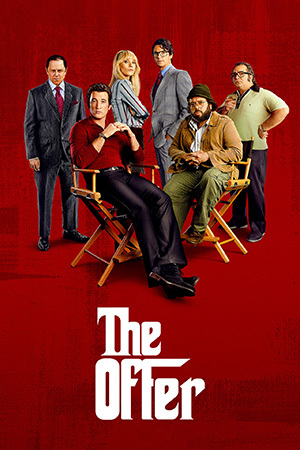
As good as Gaslit is, The Offer is my favorite of all these, the series both Barb and I savor every moment of. Streaming on Paramount (a company the series regularly skewers), The Offer is a behind-the-scenes look at the making of The Godfather. This, too, finds comic melodrama in the proceedings but is less heavy-handed than Candy and Pam (yet how I would love to see Candy Montgomery Vs. Pam Hupp: The Final Showdown). Some reviewers haven’t liked The Offer, but actual humans probably will. The cast is wonderful, with Matthew Goode’s Robert Evans a stunning thing to behold, while quietly charismatic Miles Teller holds everything together as producer Al Ruddy, the pole that holds the tent up. Also outstanding, among a flawless ensemble, are Juno Temple, Dan Fogler and Giovanni Ribisi.
Finally, Better Call Saul on AMC is in its final season (broken in two, as was the case with Ozark). I find its narrative style fascinating – often the story proceeds at a crawl, raising more questions than answers, and yet you hang right with it. I keep thinking about how that approach could transfer to prose.
* * *Scott D. Parker, in his article “Legacy Authors and That Last Book,” compares aging rock bands who record a last song and/or album, knowing it will be their last, to authors who may write a book about an enduring character, knowing it will be the last.
Parker invokes me and some of my ruminations here about slowing down, and specifically wonders if I’ll know when I’m sitting at the computer to work on my final Heller novel. The truth is I don’t know. I have one more Heller to write on the current Hard Case Crime contract, and – as The Big Bundle won’t be out till early December – I don’t yet know how the HCC audience will take to Nate Heller. I am confident that Heller is my most important work and my best shot at being read years after I’m gone.
And Sir Arthur Conan Doyle was convinced his enduring contribution would be those historical epics nobody reads any more.
For me, it’s a matter of paying attention to my health. I’ve had two good reports in recent days and it looks like – aside from getting hit by a bus or something the docs overlooked – I’ll be around a while. I have every expectation this next Heller will get written.
Will it be the last?
I don’t know. Parker wonders if mystery writers realize their characters are getting older. Well, some ignore it. Stout would have characters from previous novels show up having aged on Archie and Wolfe’s doorstep, while Goodwin and Nero remain in the same frozen-in-time state. Mickey Spillane, in advertising for The Killing Man, appeared in Miller Lite trenchcoat-and-fedora drag saying, “I got older – Mike didn’t.”
But he did. Like Jack Benny, Mike Hammer didn’t admit to being older than 39, but he clearly was. He was a guy who’d fought in the Pacific in World War II, using a cell phone in Black Alley (1996). I have made a point, in my collaborations with Mickey, to be more up front about Mike’s age. I fudge it a little, though.
In our Antiques series, Barb and I have to dance around the aging problem all the time. We want the books to be contemporary, so mentions of current political figures and pop culture come in – but we only move the pieces on the chessboard ahead one-season-per-book. In other words, for every four books, one year has passed in the lives of Brandy and Mother. Less than five years in real time elapse over 15 or 16 novels, yet they are moving through time at the same rate as the rest of us.
My late friend Paul Thomas, my musical collaborator, used to say about such things, “If you buy any of it, you buy all of it.”
I think I am more inclined to age my characters more normally than most mystery writers. Quarry’s age can be calculated, and so can Nate Heller’s. But one thing is for sure: me? I am moving only in one direction.
* * *Here are eleven “intoxicating” crime books set in Las Vegas. They include Skim Deep, but should have made it a dozen with Neon Mirage.
I get a nice mention in this very good article, “A Primer on Crime Fiction.”
I receive a left-handed compliment in this look at the great Batman eras.
M.A.C.
May 17, 2022
A Shameless Excursion Into Self-Promotion
A reminder: today is the publication date of Stand Up and Die! (the new collection of Mickey Spillane’s novellas and short stories from Rough Edges Press, edited by me and with a Mike Hammer short story co-written by Mickey and me).
The new crime/horror novel, The Menace, by Mickey Spillane and me is $3.99 on Kindle at Amazon.
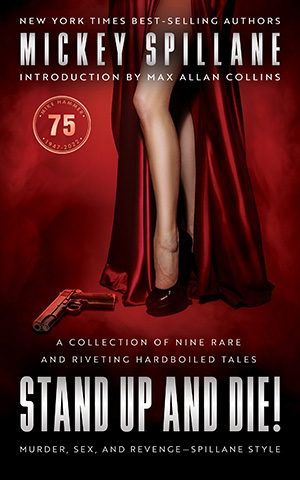
Trade Paperback:





E-Book:

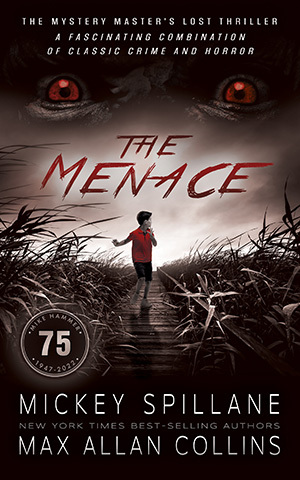
Trade Paperback:





E-Book:

The Menace just came out and is, as may already know, developed by me from an unproduced Mickey Spillane screenplay. If you’re not a horror fan, don’t be put off: it’s fundamentally a crime novel. It’s rather short – though not, as some have described a novella (it’s 40,000-words), but two additional Spillane pieces are included as a bonus at the back – the previously unpublished original version of his comic tale, “The Duke Alexander,” and a rare true-crime article.
For you physical media types (like me), the handsome trade paperback edition is just $9.99 at Amazon right now.
This update exists as a place for me to share views on pop culture, talk about what’s going on with me (and my wife Barb) personally and professionally. Part of that is letting you know about sales going on at Amazon (and elsewhere). There are several worth making you aware of going on right now.
On sale is Supreme Justice, the first of the political-thriller trilogy Matt Clemens and I wrote about Joe Reeder and Patti Rogers. Sales have stayed strong since its publication in 2014 – I believe it’s sold something like 150,000 copies, and the two sequels (Fate of the Union and Executive Order have done very well, too. Something like 350,000 copies of the Reeder and Rogers trilogy have been sold. Supreme Justice on Kindle is just $1.99 (till the end of the month).
Supreme Justice – the trade paper edition is $14.95 – has generated renewed interest because the plot concerns an attempt to rearrange the Supreme Court’s political slant by killing conservative members. It’s set in the near future, after the court overturns Roe V. Wade – again, it was published in 2014.
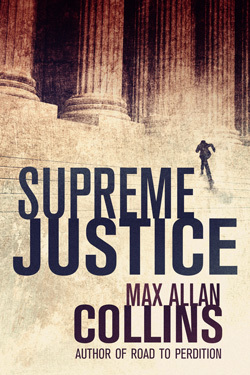
Paperback:

E-Book:

Audio MP3 CD:

Audio CD:

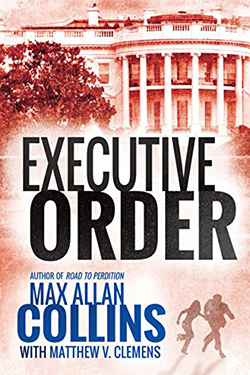
Paperback:

E-Book:

Audio MP3 CD:

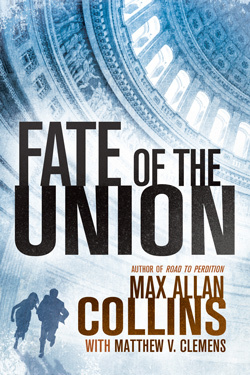
Paperback:

E-Book:

Audio MP3 CD:

My eco-thriller, Midnight Haul, is also on sale on Kindle for $1.99.
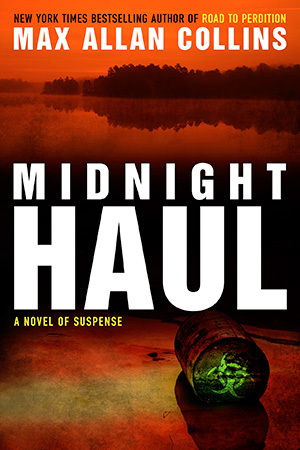
Paperback:

E-Book:

Audio CD:

Audible:

This leads me into what will undoubtedly be a self-serving discussion – a shameless one at that – hoping to convince you to try novels of mine that you may have avoided. Things that may have been out of your comfort zone. Like Supreme Justice, for example.
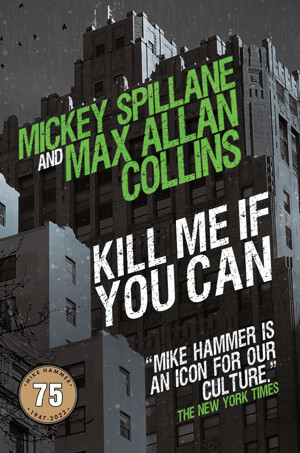
Hardcover:





E-Book:





I have talked here more than once about the reasons why I sometimes work outside of the Quarry, Nolan, Nate Heller and Mike Hammer noir-ish area. The truth is I have readers who follow one or two of those series, but avoid the others. The Quarry and Nolan novels are books in the 50,000 to 60,000-word range and are fast and (I hope) fun reads. The Mike Hammer novels, also in that word-length range, are overlooked by some of my readers because those readers are not Spillane fans or simply don’t care for books that continue a series created by someone else. Similarly, some Spillane fans don’t try these continuation novels, even though the books all have Spillane content (some a good deal of Spillane content), because Mickey himself did not write every word. The fact that Mickey engaged me to complete his unfinished material does not convince these stubborn souls. Kill Me If You Can, celebrating the 75th anniversary of Mike Hammer’s first appearance in 1947’s I, the Jury, is a novel developed from an unproduced Spillane teleplay, and it looks at the period between Kiss Me, Deadly (1952) and The Girl Hunters (1962), when Velda goes missing. It’s Mike at his most psychotic. Pre-order it through the links on the left.
That the Caleb York novels are westerns discourages some readers, who prefer crime/mystery, and that the first novel of the six is a novelization of an unproduced Mickey Spillane screenplay does not sway them. I think they’re missing out.
And of course the cozy Antiques mysteries written by Barb and me are not the hardboiled fare many of my readers enjoy, though the humor and murder content are high. I get that this approach isn’t for everybody, but will point out that the Trash ‘n’ Treasures mysteries are the series of mine with the most entries. The new one will be out in October and can be pre-ordered through the links below.
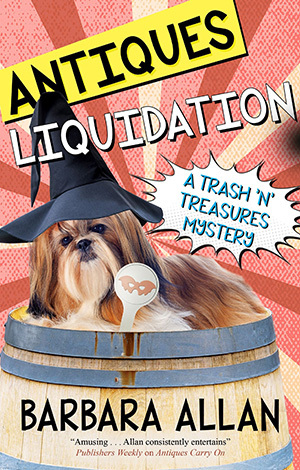
Hardcover:





Some fans of my hardboiled books avoid the Nate Heller novels, which run in the 75,000-word to 150,000-word range, their lengths off-putting to at least a few readers. The true crime basis of the novels also discourages some Quarry/Nolan fans. The Big Bundle, coming out Dec. 6 (and available for pre-order now), will be the first Hard Case Crime publication of a Heller, and I think Quarry and Nolan fans who haven’t tried the series before will find themselves at home.
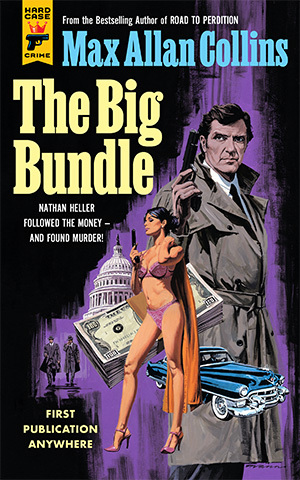
Hardcover:





E-Book:






Now I don’t expect any of you – except the hardier souls among you – to buy, read and like everything I put out. Over the last ten years or so, I have increased my already prolific output considerably. I understand that you have only so many hours available to devote to your reading pleasure, and that (however misguidedly) you have other authors you like to read who aren’t me.
So why do I write so much? My standard answer for that is, “If I don’t, they don’t send money to my house.” And that flip response is true enough. But I have also been aware of the ticking clock of mortality and realize that once I am dead, my output will slow considerably. You readers who outlive me will probably have plenty of my stuff to catch up on. That’s fine. It’s as close to living forever as I’ll come.
And I feel I stay fresh by not writing just one thing. I shudder to think if Quarry had taken off in the mid-‘70s and that what I would be doing right now is writing book #45 in the series.
What I’d like to do with the rest of this ridiculously self-serving column is ask you to read – to buy, actually, and then read – a few of my recent books that you may have skipped. I’ve already mentioned The Menace, which some might pass on because (a) it appears to be horror, and/or (b) it doesn’t feature Mike Hammer. I can only say that Mickey came up with a good story and I developed it into a good novel that I’m very proud of.
Here are a couple of others you may have overlooked.
Fancy Anders Goes to War is a novella available on Kindle but also has a handsome little trade paperback with a wonderful Fay Dalton cover (and interior illos). It’s a private eye story with a new heroine who has much in common with Ms. Tree but is also her own girl (it’s a ‘40s story so I can call her that, and anyway she’s young). The research is Heller level. It’s the first of three such novellas from Neo-Text. I just loved writing it (and its two follow-ups, the second of which will be out before long). On Kindle it’s 2.99 and the paperback is only $6.99.
The audio of Fancy Anders Goes to War from SkyBoat is outstanding, virtually a movie for the ears.
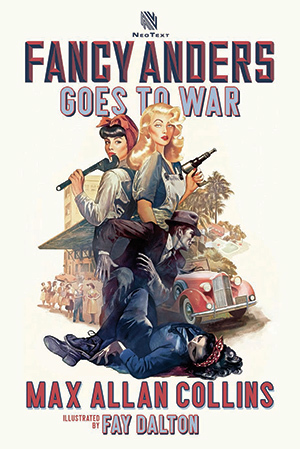
E-Book:

Trade Paperback:

Digital Audiobook:

Girl Most Likely and Girl Can’t Help It are two books that have suffered a handful of bad reviews and a wealth of good ones that haven’t overcome that handful. This was my attempt to do something along the lines of an American version of Nordic noir. The detectives are a young woman police chief and her retired homicide cop father in Galena, Illinois (I had the cooperation of the town’s police chief, female). I like these books a lot but they didn’t do as well as previous Thomas & Mercer titles. Girl Can’t Help It touches heavily on my rock ‘n’ experience. If you like my work at all, give these a try. They are $4.99 each on Kindle and $10.93 and $12.83 respectively as trade paperbacks.

Paperback:



E-Book:

Digital Audiobook:

MP3 CD:

Audio CD:


Paperback:



E-Book:

Digital Audiobook:

MP3 CD:

Audio CD:

Finally, one of my favorites among all of my novels: The Many Lives of Jimmy Leighton, written with SCTV’s Dave Thomas. Two things seem to get in the way of my regular readership trying this one: the science-fiction aspect, and the assumption that it’s a comedy. Where to begin? This novel is as much a crime story as s-f, with an older male Black cop and a young female Gen Z partner struggling to find out who shot smalltime thief Jimmy Leighton, who is in the hospital in a coma. Meanwhile, Jimmy, who accidentally triggered a quantum experiment in the basement lab he broke into, is careening from one lifetime to another. The chapters alternate between the cops working on the crime and Jimmy’s journeying.
As for the book being mistaken for a yuk fest, my co-writer Dave Thomas was a writer and producer on the TV series Bones and Blacklist. So there.
Some have characterized Jimmy’s adventures in terms of the old Quantum Leap TV series. While there is some similarity, there’s a major difference. Dave and I, who wrote this book together during the Covid lockdown (lots of phone calls and Zoom get-togethers), wanted to avoid the notion that our traveler would find himself a jet pilot, or on a Broadway stage, or in the middle of doing brain surgery. Jimmy is encountering different lives of his – the different paths he might have taken – possible lives, not unlikely ones.
For me – and for Dave, too – this is a novel that has more to do with Groundhog Day or A Christmas Carol than Quantum Leap. And the science-fiction aspect – Dave takes his quantum science very seriously – is like the history in Nate Heller. It’s important, and it strives to be right; but it’s not the story. If you trust me at all, know that in my opinion The Many Lives of Jimmy Leighton is one of the best books in my catalogue.
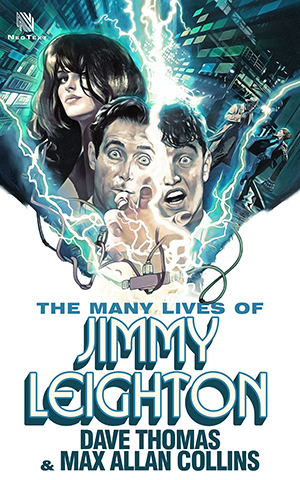
E-Book:

Trade Paperback:

Finally, for those of you who – like me – stubbornly insist on prowling actual bookstores, you must accept the fact that most of these books almost certainly will not be found in the world of brick-and-mortar. Supreme Justice and its two sequels, and the two Girl novels with Krista Larson and her dad, are mostly available at Amazon (physical copies at Barnes & Noble and others, but Kindle is Amazon). So is The Menace. Neo-Text books – Fancy Anders Goes to War and The Many Lives of Jimmy Leighton – are Amazon.
* * *Speaking of Supreme Justice, it has made another list of the best legal thrillers.
And here’s a great review of Tough Tender, the Hard Case Crime two-fer of Hard Cash and Scratch Fever with Nolan and Jon.
M.A.C.
May 10, 2022
Sit Down and Read!
STOP THE PRESSES: Supreme Justice and Midnight Haul are on sale for $1.99 each as Mystery, Thriller and Suspense Kindle book deals till the end of May. Amazon links: Supreme Justice | Midnight Haul
* * *
Trade Paperback:





E-Book:

Stand Up and Die!, the new Mickey Spillane collection from Wolfpack’s Rough Edges imprint, goes on sale next week (May 17) as both a Kindle e-book and a physical book. I edited it (and introduced it) and contributed a new version of my very first collaboration on a Mike Hammer story with Mickey, “Tonight I Die” (originally titled “The Night I Died” and published in the Spillane/Collins-edited anthology, The Private Eyes, 1998).
These novellas and short stories are culled from two long-out-of-print anthologies I edited, Tomorrow I Die (1986, Mysterious Press) and Together We Kill (2001, Five Star). This represents all of the crime stories from both volumes collected here in one place.
Here are the contents:
“Stand Up and Die!” (1958)“Everybody’s Watching Me” (1953)
“Together We Kill” (1953)
“The Girl Behind the Hedge” (1953)
“The Pickpocket” (1954)
“I’ll Die Tomorrow” (1960)
“Tomorrow I Die” (1956)
“Hot Cat” (1964)
“The Gold Fever Tapes” (1973)
“Tonight I Die” (2022)
The final story is a Mike Hammer tale, and the reason why I’ve done a new version – not radically different, but enough so to rename it – is a story unto itself.
The basic story of “Tonight I Die” appeared in three versions in Mickey’s files – a radio play, a thirty-minute TV show, and a sixty-minute or more TV movie. There are significant differences between versions, and I did not become aware of all three until much later.
In 1998, when we edited the anthology Private Eyes for NAL, I felt it was key that we include a Hammer short story. But there weren’t any and getting Mickey to write a new one would have tough to impossible. He had already begun to share his unpublished materials with me, just for my interest (and perhaps he was already thinking of what I might do with his unfinished work some day), and I had run across the radio play version. It seems to have been written for the radio series That Hammer Guy, possibly as a pilot. It was not to my knowledge produced, though the series ran three years.
The script was heavy with narration and I asked Mickey if I could turn it into a short story, sticking to his script. He gave his blessing. The script was heavy with narration and the transfer was not difficult, though I felt some of it could have used some work, chiefly for clarity. But I did as little as I could in that regard, basically turning the script’s present tense script into past.
Now that I’ve done so many posthumous collaborations with Mickey – with his blessing – I felt this story should be properly prepared for publication…again, without taking too many liberties.
The things I did not include from the Tomorrow I Die and Together We Kill anthologies in this new one are interesting but not vital – like the science-fiction tale “The Veiled Woman,” ghosted by Howard Browne when Mickey missed deadline; a few memoirs for True magazine; a comic book “filler” story (now available in Vintage Spillane); and the script of a Mike Hammer screen test film starring Spillane’s policeman pal Jack Stang (a short story version appearing in the forthcoming Kill Me If You Can, this year’s Hammer 75th anniversary novel, which includes five bonus short stories). Also intentionally M.I.A. is Mickey’s good but non-crime tale, “Affair with the Dragon Lady.”
Stand Up and Die! is the definitive collection of Spillane crime/mystery short fiction, and its existence is due to not just my efforts but also Wolfpack’s Mike Bray, Paul Bishop and James Reasoner.
Mickey allowed a number of his crime novellas to be collected by NAL as paperbacks, mostly two-to-a-volume. This was part of his effort to raise last-minute funds for the troubled production of The Girl Hunters film. Possibly because that need for money was over, he did not bother to collect his other novellas and short stories similarly. Over the years I collected these in their original men’s adventure magazine appearances, sometimes off the newsstands, other times in used book stores. Convincing Mickey to let me collect some of them for the Mysterious Press anthology led to our first professional project together.
Not our last.
I can’t recommend a collection of tough fiction more highly than this one.
* * *Here’s a good review of Quarry’s Blood by a reader who can’t seem to make up his mind whether he wants me to write more Quarry books or not.
This review of the film The Outfit, streaming now, says it’s a combination of Collins (me), Mamet (a writer whose work I don’t care for), and Sorkin (a writer whose work I do care for). So I went into watching it with one eye squinted. It’s an okay crime chamber piece, with a strong central performance by Mark Rylance. You may like it. I made it all the way through, Barb didn’t. Interestingly, Barb loves the film of Tinker, Tailor, Soldier, Spy (as do I), and the reviewer here in passing calls Tinker, Tailor “dreadfully boring.” Still, having my work referenced in a review like this was fun.
Some short, smart reviews here of three Quarry books and one Nolan. I’m blushing.
Road to Perdition is listed as one of the seven best movies debuting on Netflix in May 2022.
Here’s an interesting in-depth look at Wild Dog.
Finally, this brief, admiring look at the graphic novel and film of Road to Perdition.
M.A.C.



